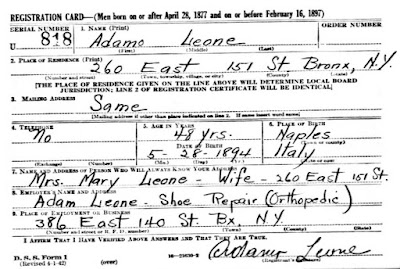My father's parents were third cousins. That was a bit of a surprise, but not a shock because they had the same last name.
All of their descendants have been great students and done well for themselves. No harm, no foul.
This past holiday weekend I began going through the vital records I'd downloaded from the Italian archives for my ancestral town of Sant'Angelo a Cupolo.
My goal: figure out if my great aunt Stella was related to her husband Attilio who had the same last name as her.
 |
| Attilio's 1924 passport photo. |
This is an interesting family, and it became more curious as I sifted through the documents.
Carmine and Maria Rosa were married in Italy and had 3 babies. Carmine was "absent in America" when the first child was born, and he'd gone back and forth from the Bronx to Sant'Angelo a Cupolo many times. He was naturalized as early as 1899.
In 1904 Carmine and Maria Rosa and two of their children (the third must have died) came to America. While they lived in the Bronx, they had two sons, Enrico and Attilio, in 1906 and 1907.
I know from his passport papers that Attilio went to visit his family in Italy in 1924. On his application he stated that he had been in America ever since he was born in 1907.
But here's the shocking part.
Carmine and Maria Rosa went back to Italy as early as 1915, leaving young Enrico and Attilio behind. They had another child in Sant'Angelo a Cupolo in 1916.
There is no evidence that they ever returned to America, despite the fact that Carmine was a U.S. citizen.
If the parents left America in 1915, Enrico was nine and Attilio was eight. Enrico went to see his family when he was 17; Attilio went a year later when he was 17.
Meanwhile, I cannot find the boys in any census records until they are grown men.
Who was caring for the two boys?
I searched for families that had the same name as the boys' mother—dell'Aquila. I'd hoped to find them as part of an extended family household where they were receiving the full benefit of their U.S. citizenship.
But I can't find the boys anywhere.
Unless more vital records are put online, I can't find out who Carmine's parents are. I can't tell his exact link to my bloodline. But in such a small town, I don't think there was enough room for unrelated families with the same uncommon name.
I'll keep on piecing together the entire town of Sant'Angelo a Cupolo and hope I can find the missing link.















